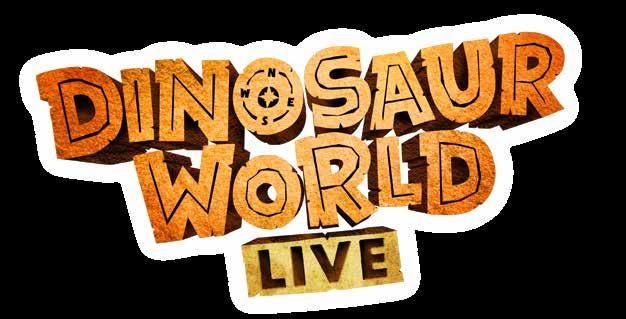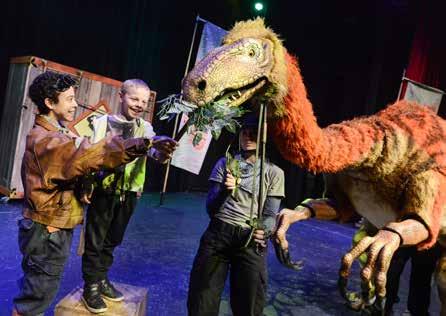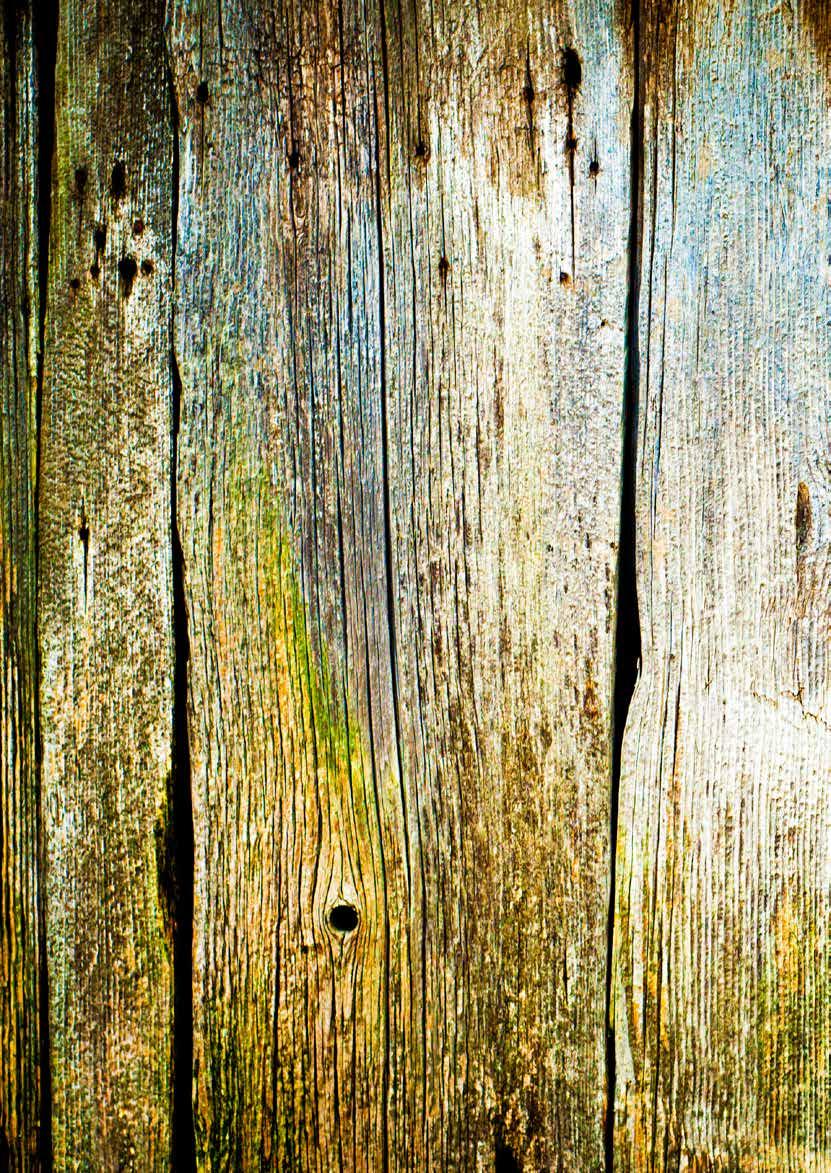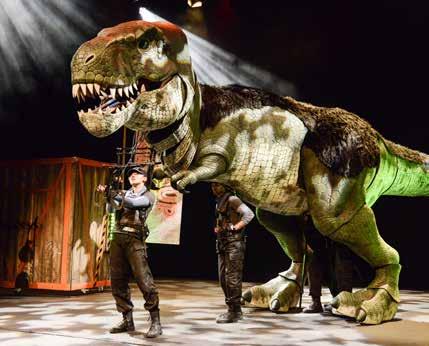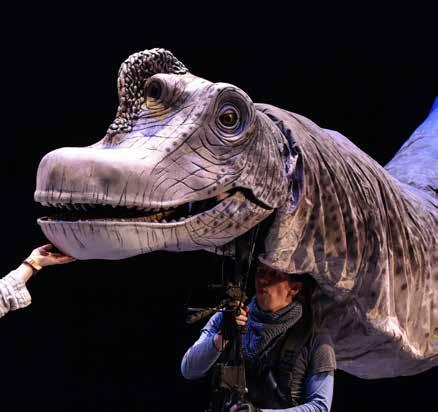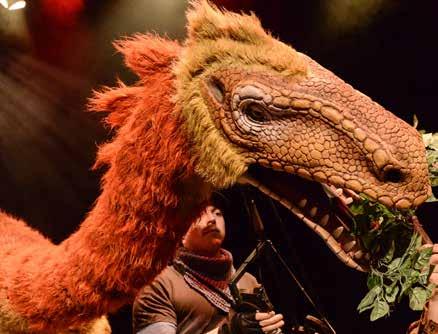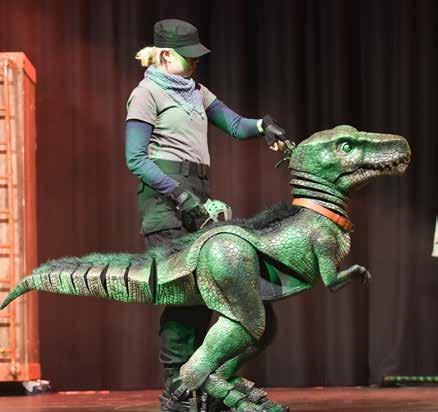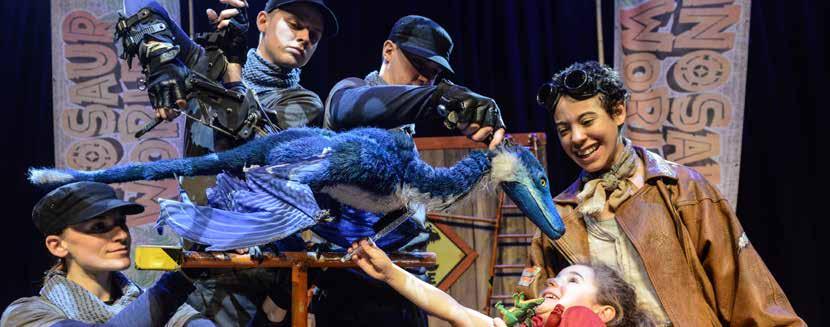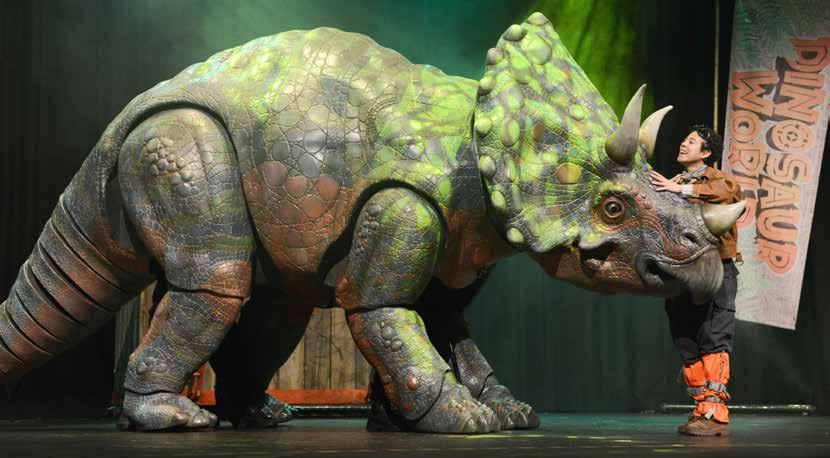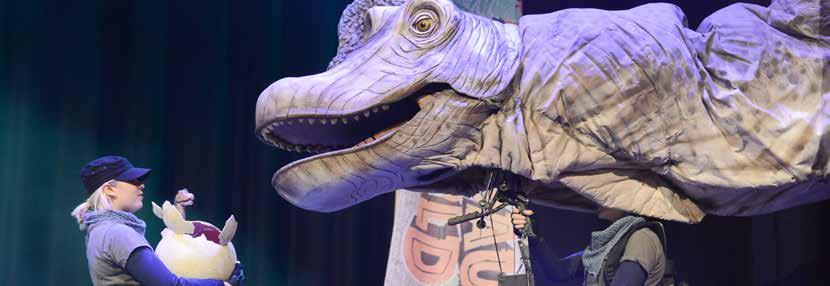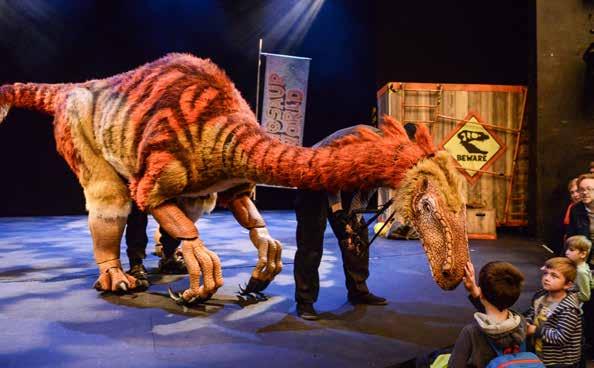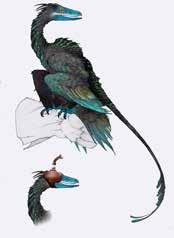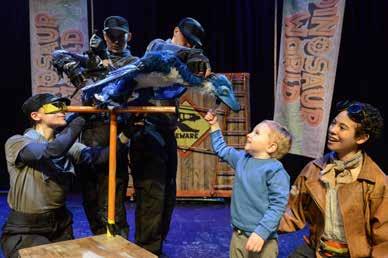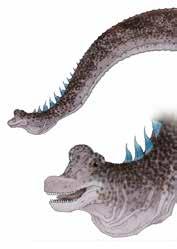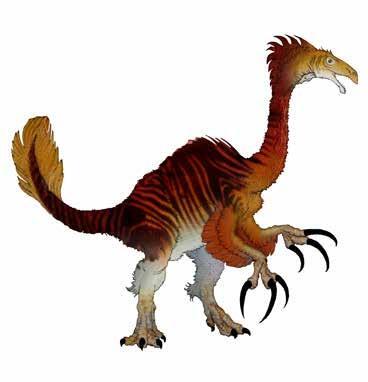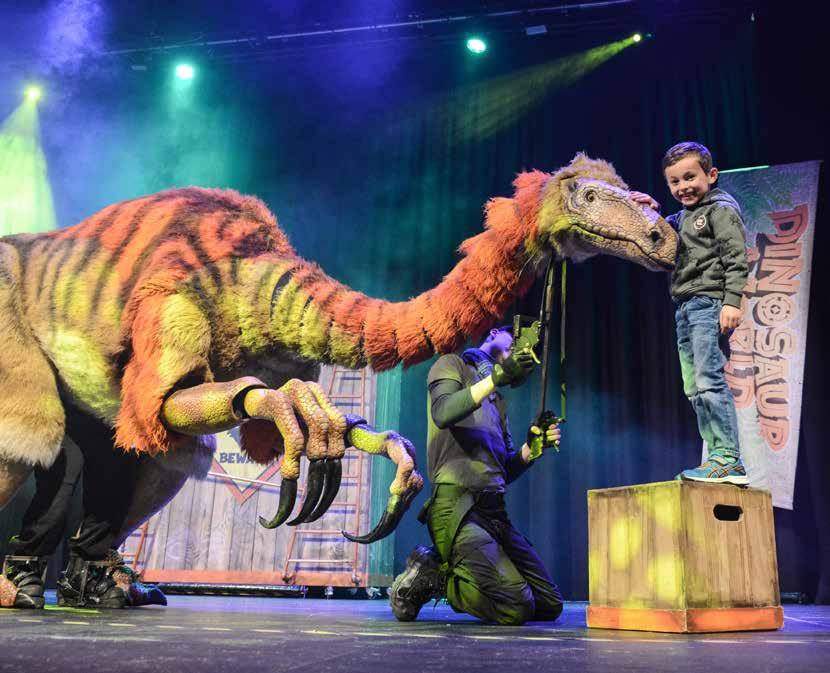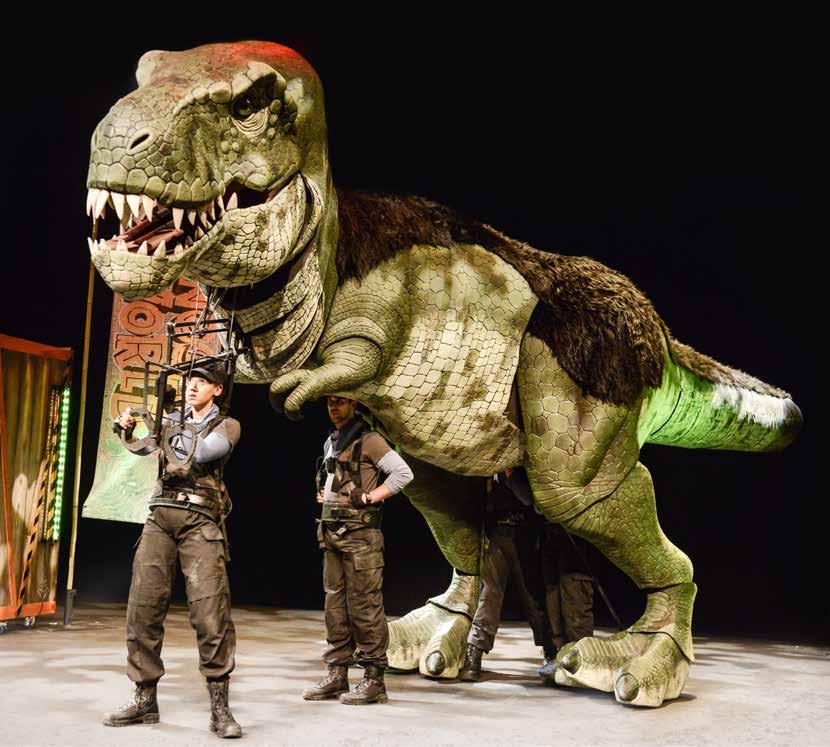NAME BEATRICE
TYPE OF DINOSAUR TRICERATOPS
WHAT DID THEY EAT? PLANTS GROWING LOW ON THE GROUND - BEATRICE IS A HERBIVORE
HOW DID THEY MOVE? MOVES HER HEAD, USING THE FRILLS AROUND IT TO SAY HELLO TO OTHER TRICERATOPS
WHERE DID THEY LIVE? NORTH AMERICA
SOMETIMES OTHER DINOSAURS - TAMORA IS A CARNIVORE
HOW DID THEY MOVE? JUMPS FROM SIDE TO SIDE ON HER BACK LEGS, HER FRONT LEGS ARE HELD UP
WHERE DID THEY LIVE? NORTH AMERICA
Fill in the missing dinosaurs!
1. The biggest dinosaur we met was She was bigger than all the other dinosaurs.
2. We also met a big Tyrannosaurus Rex called Titus! He was bigger than the
3. We met a small flying creature called Orlando the Microraptor. Who was bigger: Orlando the Microraptor or Juliet the Segnosaurus?
Who was smaller? Beatrice the baby Triceratops or Tamora the young T Rex?
Extension:
Using the information sheet to remind you of all the different dinosaurs you met, can you put the dinosaurs in size order?
1. The biggest dinosaur we met was Gertrude the Giraffatitan.
2. Titus the Tyrannosaurus Rex was bigger than any of the other dinosaurs except the Giraffatitan, so accept all possible answers!
3. Who was bigger? Juliet the Segnosaurus was bigger than Orlando the Microraptor.
4. Who was smaller? Beatrice the baby Triceratops was smaller than Tamora the young T Rex
In order of size from smallest to largest, the dinosaurs were:
Beatrice the baby Triceratops
Orlando the Microraptor
Tamora the young T Rex
Juliet the Segnosaurus
Titus the adult T Rex
Gertrude the Giraffatitan
[Maths – NC requirement to “compare…lengths and heights”]
This session is designed to last around 45 minutes, and can be delivered to your students as a follow-up to your trip to the theatre.
RESOURCES NEEDED:
A space large enough for your students to move around in – a classroom is fine if furniture is moved to the sides. Some upbeat music for the warm up can be useful. If you want to really go for it you could get some jungle sounds to play in the background during your trip around the island!
TASK: CIRCLE TIME
TIME: 5 minutes
The children start in a circle and the teacher explains that we are going to have a drama adventure based on the theatre trip to see the dinosaurs.
PURPOSE: To start off the session clearly and make it clear to the children that they are going to use their imaginations for the drama session.
TIPS: It can be useful to introduce a FREEZE instruction at this point; you could use one that the children are already used to in school, or you could introduce a drama themed one e.g. when the teacher calls out ‘Dinosaur!’, all the children freeze in their scariest dinosaur statue. It helps to emphasise that statues cannot move or talk, and to have a practice go a few times.
LINK TO NEXT ACTIVITY: The teacher can explain that we need to warm up if we are going on a dinosaur adventure, as you have to be fit and healthy to be an explorer like Miranda in the show. At the end of the teacher’s talk you can give the children ten seconds to find a space facing you all spread out.
TASK: WARM UP
TIME: 5 minutes
The children are led in an energetic warm up where they copy the actions of the teacher at the front. These can include simple keeping fit moves, and also getting their explorer ‘clothing’ on (imaginary).
PURPOSE: To focus the children on getting used to working physically, and get their imaginations warmed up as well.
TIPS: It helps to use a piece of really upbeat music for this. Suggested moves include: hands on heads, shoulders etc. marching on the spot, wiggling hands, shoulders, hips, knees, feet, stretching up high/down low, swaying from side to side like a dinosaur, stomping like a dinosaur, then move into getting explorer suit on, pulling it over legs and arms, getting your hat on, getting your boots on.
LINK TO NEXT ACTIVITY: The imaginary putting on of the Explorer suit can lead directly into the teacher saying that it’s time to get all of our exploring equipment ready.
TASK:
EXPLORERS GET READY
TIME: 5 minutes
The teacher gives the children a countdown to pack their imaginary Explorer rucksacks and come and sit down ready in the ‘boat’ (on the floor by the teacher). They should ‘pack’ everything they think they might need to explore the island where the dinosaurs live. When the countdown finishes, the children can share what kind of things they have decided to bring with them.
PURPOSE: To engage the children’s imagination and get them to contribute imaginatively to the adventure.
TIPS: The teacher can give the children between 10-30 seconds, it works best when the countdown is kept going nice and dramatically! The teacher can throw in suggestions, for example to encourage the children to think about where they are going (near Argentina), whether they need particular things to wear or eat, or help them get around the island.
LINK TO NEXT ACTIVITY: When the children have shared their suggestions, it is time to get into the boat and get going to Argentina!
TASK:
TRIP AROUND THE ISLAND
TIME: 5 -10 minutes
The teacher leads the children on an imaginary journey around Miranda’s island, starting with sailing there and landing on the beach. As they ‘travel’ around the island/from corner to corner of the room, they must dodge the different obstacles:
- Wave! It’s Juliet the Segnosaurus
- Duck! Orlando the Microraptor is flying overhead
- Freeze! There goes Tamora the T Rex – could we throw her a ball to distract her?
- Wait! We can hear Beatrice the baby Triceratops – what could we sing to her to get her to sleep?
- Hush! Here’s the Giraffatitan nest – we can help rescue her eggs so that she doesn’t accidentally step on them, let’s gently gather them up and put them somewhere safe
PURPOSE: To develop the children’s imagination and revive their memory of the different dinosaurs
TIPS: The trip to the island can be done with all the children sitting down, the teacher can make the water choppy/calm etc., and then can ask if the children see anything in the sea?
When you ‘land’ on the island it can work really well to have the children creep along so that you don’t disturb the dinosaurs. As the teacher goes through the different instructions, the children might start to guess what’s coming, so if you see something ‘flying’ overhead, they can be encouraged to guess who it is, and what dinosaur he is/what colour is he etc.?
LINK TO NEXT ACTIVITY: Remind the children that there is one of the dinosaurs they haven’t seen yet – can they remember the big Tyrannosaurus Rex’s name?
TASK: FREEZE!
TIME: 5 minutes
The teacher lines up the children against one end of the room and explains that Titus the Tyrannosaurus Rex can only see things when they move. The children have to try and creep across the room, with the teacher or a chosen child as ‘Titus’. ‘Titus’ turns his back on the children and then turns around. Anyone who is moving is ‘out’…they might even be turned into the T Rex’s tea….
PURPOSE: To practice body control and different speeds of movement
TIPS: It helps to get the children to practice ‘creeping’ first and to make it really clear that if they move when the ‘T Rex’ is looking their way then they will be sent back to the beginning. The teacher can create a bit of a grumpy character as the ‘T Rex’, who is looking for things that are moving but can’t seem to find anything!
LINK TO NEXT ACTIVITY: The teacher can point out that it’s not just Titus who is hungry, all of the dinosaurs must be hungry by now so we could find them something to eat.
TASK: DINOSAUR
PICNIC
TIME: 5 - 10 minutes
The children gather food for the dinosaurs – can they remember what each dinosaur ate? Then they put them in the middle of the circle and explain who might enjoy each type of food. Next everyone settles down for the dinosaur picnic – and this leads into the next task of using imagination to become each of the dinosaurs in turn.
PURPOSE: To reinforce the memory of what each dinosaur ate and emphasise the difference between carnivores and herbivores.
TIPS: The teacher can guide the children by asking them to think about what there could be for the dinosaurs to eat on the island. The children might suggest plants etc. and the teacher can then see if they remember who eats those. For guidance: Leaves/plants-Segnosaurus, Triceratops, Giraffatitan; Seeds, fish-Microraptor; Chicken-Tyrannosaurus Rex
LINK TO NEXT ACTIVITY: The teacher leads the children in an imagination exercise: with all this food the dinosaurs are attracted to this spot, but what if we turned into the dinosaurs…
TASK: DINOSAUR RAMPAGE!
TIME: 5 minutes
The teacher leads the children through each dinosaur and gets them to move around the room as each dinosaur:
- Segnosaurus – moves from side to side, moves her head when she’s hungry
- Microraptor – flies and swoops down for seeds
- Triceratops – quite stompy, the frill around the head can be used to say hello to other dinosaurs
- Tyrannosaurus Rex – can run, hold her front legs in front of her, moves her head a lot
- Giraffatitan – huge! She could build the nest i.e. scrapes out a shallow hole, drop the eggs in (up to about 30) and cover them with earth. (They will be hatched by the warmth of the sun)
PURPOSE: To reinforce the differences between the dinosaurs
TIPS: You can bring this active exercise to a close by magically turning all the children back into their normal selves, e.g. by using your FREEZE/’Dinosaur!’ instruction as set up at the start of the session. This can also be to keep them focused in between each dinosaur.
LINK TO NEXT ACTIVITY: The FREEZE instruction can be used to finish off, then the teacher could give the children a slow countdown (e.g. from five) and explain that when they reach zero the children will have turned back into themselves, and they must creep into a circle as it is time for all the dinosaurs to have some rest.
TASK: COOL DOWN
TIME: 5 minutes
Back in a circle, the children close their eyes and imagine they can send a message back in time to the dinosaurs. What message would they like to send? They can then whisper it into the air and bring the session to an end.
PURPOSE: To round off the session and calm the children down after an exciting activity.
TIPS: This can be a good place to remind the children that now we are going to leave the world of dinosaurs behind and return to our school. If you want to you can get back on the ‘boat’ and sail off, waving goodbye to the dinosaurs.
LINK TO NEXT ACTIVITY: You could lead into doing an Art activity where the children draw or paint one of the dinosaurs they have met.
Dinosaurs lived a long time ago, before humans even existed. The reason we know about dinosaurs is because scientists have found FOSSILS.
Fossils are formed when bits of dinosaurs (teeth or bones) were kept in the earth and over a very long time turned into rock.
Scientists have also found dinosaur footprints that have turned into fossils over time.
Let’s have a go at making your own footprints into fossils! You will need:
A plastic container
Some modelling clay
Plaster of paris mixed with water (each child will only need about a half a cup full)
1. Put some clay in the bottom of your plastic container
2. Press your footprint (or handprint) into the clay. You could use a small plastic toy
The following activities are short tasks that match up to some of the curriculum requirements for your children.
CARNIVORE, HERBIVORE, OMNIVORE?
Children have to match up each dinosaur to its type.
Segnosaurus –
Microraptor –
Triceratops – Herbivore
Tyrannosaurus Rex – Carnivore
Giraffatitan – Herbivore
Human – Omnivore
NB herbivore dinosaurs did not eat grass as it did not evolve until after the dinosaurs became extinct
DID YOU KNOW?
We know what each type of dinosaur ate because of their teeth. Carnivores have sharp teeth and Herbivores have flat topped teeth.
If you look at your own teeth you will see that humans have a mix of different types of teeth, meaning we are omnivores who can choose to eat both meat and plants.
[Science – NC requirement to “identify and name a variety of common animals that are carnivores, herbivores and omnivores “]
ART ATTACK
Choose one of the dinosaurs and draw them with what they like to eat!
[Art – NC requirement to “use drawing, painting and sculpture to develop and share their ideas, experiences and imagination”]
WHERE IN THE WORLD?
Locate on a map of the world where the different dinosaurs lived:
- Segnosaurus in Mongolia, Asia
- Microraptor in Germany, Europe
- Triceratops and Tyrannosaurus Rex in North America
- Giraffatitan in Africa
- Miranda, the dinosaur expert in the show, lived on an island off Argentina, South America
[Geography – NC requirement to “name and locate the world’s seven continents”]
CAN YOU SPELL IT?
The teacher reads out (letter by letter) the spelling of each dinosaur seen in the show and the children write down the letters. Have they got it right at the end?
A child could be chosen to read out the letters as well. Points could be given for each table that gets it right.
SEGNOSAURUS
MICRORAPTOR
TRICERATOPS
TYRANNOSAURUS REX
GIRAFFATITAN
All our suggested activities are linked to the National Curriculum in England Programmes of Study for Key Stage 1.
For each activity, we have listed the corresponding Statutory requirements that are fulfilled:
BIGGEST AND SMALLEST
Programme of Study for Maths (Measurement):
‘Pupils should be taught to…compare, describe and solve practical problems for lengths and heights’
DINO DRAMA!
Programme of Study for English (Spoken language):
‘Pupils should be taught to…Listen and respond appropriately to adults and their peers’ Use spoken language to develop understanding through…imagining’ Participate in…role play’
Programme of Study for Physical education:
‘Pupils should develop fundamental movement skills…They should be able to engage in…co-operative physical activities’
FOSSIL MAKERS!
Programme of Study for Art and design:
‘Pupils should be taught to…use a range of materials creatively’
CARNIVORE, HERBIVORE, OMNIVORE?
Programme of Study for Science (Animals, including humans):
‘Pupils should be taught to…identify and name a variety of common animals that are carnivores, herbivores and omnivores’
ART ATTACK
Programme of Study for Art and design:
‘Pupils should be taught to…use drawing… to develop and share their ideas, experiences and imagination’
WHERE IN THE WORLD?
Programme of Study for Geography:
‘Pupils should be taught to...name and locate the world’s seven continents’
CAN YOU SPELL IT?
Programme of Study for English (Writing – transcription):
‘Pupils should be taught to…name the letters of the alphabet’
Max Humphries, who is known Dinosaur World Live, Max and his team have produced work for the National Theatre, the Royal Opera House, the , and you can read his
What are the dinosaurs made of?
They’re made of a skeleton of very light aluminium metal. The more complex moving parts are a mix of nylon, steel, aluminium and birch. Then over that is a skin of super-lightweight foam for the muscles and then the skin is either made out of cloth or treated fur for the feathers.
How did you come up with the designs?
After agreeing which dinosaurs we were going to be making and what each were going to do, we studied the anatomy and settled on a final drawing of each dinosaur.
Then we worked out how the puppeteers would fit inside and how all the parts moved. From that I worked out the skeleton and mechanisms whilst the rest of the team worked on sculpting the outside.
Then after the outside and inside were finished we joined them together. That is why good planning is so important; everything needs to meet together.
How long did it take you to make the dinosaurs?
From the first drawings to the first show was a little over 9 months!
What was the biggest challenge in making the dinosaurs?
Keeping them light and strong. There are no electronics or hydraulics in our puppets, everything is people-powered by our great team of puppeteers, so you have to maintain a workable weight whilst also packing the most stuff into the puppets as possible.
What is most important when making puppets?
Passion and dedication to your craft.
What is your favourite part of puppetry creation and design?
Working with my team.
What is your favourite dinosaur?
Hard question, in my heart Thalassodromeus Sethi but technically she’s a pterosaur and not a dinosaur. So i’ll probably say Amargasaurus Cazaui? But in the show I think it’s probably Tamora!
You can find out more about Dinosaur Word Live at dinosaurworldlive.com and on our social media channels below:
Facebook: @dinoworldlive
Twitter: @dinoworldlive
Instagram: @dinoworldlive
Great rates for School groups are available on tour! You can find your closest venue at dinosaurworldlive.com/tickets
The Dinosaur World Live Teachers’Resource Pack was written by Ceridwen Smith
Photos by Robert Day
